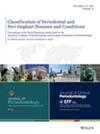Periodontitis and high phosphate intake alone or in combination adversely affect the kidney.
IF 3.8
2区 医学
Q1 DENTISTRY, ORAL SURGERY & MEDICINE
引用次数: 0
Abstract
BACKGROUND Periodontitis and high phosphate (HP) intake can negatively affect the kidney in the presence of renal disease. This study aimed to evaluate the effects of periodontitis or HP intake, either alone or concurrently, on the periodontal tissue and the kidney under normal renal conditions. METHODS Rats were divided into normal diet (C), HP diet (HP), tooth ligation and normal diet (P), and tooth ligation and HP diet (P+HP) groups. The mandibular first molars were ligated, and a 0.9% HP diet was provided for 12 weeks from the day of ligation. An additional group (P+HP+IFX) was administered infliximab (IFX), a tumor necrosis factor-alpha (TNF-α) inhibitor, weekly to evaluate the TNF-α inhibitory effect. RESULTS Alveolar bone loss and periodontal inflammation did not differ between the P and P+HP groups or between the C and HP groups. In the kidney, interstitial fibrosis and Col1a1 expression increased in the HP group, and ED1 expression increased in the P group, compared to the C group. Tubular basophilia, interstitial fibrosis, and the expression of Col1a1 and ED1 increased in the P+HP group compared to the other groups. The P+HP+IFX group showed a decrease in periodontal inflammation and these renal alterations compared to the P+HP group. CONCLUSION Regardless of periodontitis, 0.9% HP intake did not affect periodontal tissue. Renal fibrosis and macrophage infiltration induced by HP intake and periodontitis, respectively, worsened when combined, indicating a synergistic adverse effect. These changes were reversed by IFX, suggesting that TNF-α inhibition may alleviate renal injury caused by periodontitis and HP intake. PLAIN LANGUAGE SUMMARY Our study examined the impact of periodontitis and a 0.9% high phosphate (HP) diet, individually and together, on periodontal tissue and kidney. We divided rats into 4 groups: normal diet, HP diet, periodontitis with a normal diet, and periodontitis with an HP diet, and assessed various periodontal and renal parameters. Although we did not observe any effects of HP intake on periodontal tissue, we found that HP intake worsened kidney health by increasing fibrosis, while periodontitis did so by increasing macrophage infiltration. Combined, these conditions worsen kidney health more than when each condition exists alone, causing more tubular basophilia, fibrosis, and macrophage infiltration. However, these negative effects were reversed with TNF-α inhibition. These findings indicate that the combination of periodontitis and HP intake exacerbates renal damage, which can be ameliorated by TNF-α inhibition.牙周炎和高磷酸盐摄入单独或联合对肾脏有不利影响。
背景:牙周炎和高磷酸盐(HP)摄入会对肾脏产生负面影响。本研究旨在评估在正常肾脏条件下,牙周炎或HP单独或同时摄入对牙周组织和肾脏的影响。方法将大鼠分为正常饮食组(C)、HP饮食组(HP)、结扎牙组和正常饮食组(P)、结扎牙组和HP饮食组(P+HP)。结扎下颌第一磨牙,自结扎之日起饲喂0.9% HP饲粮12周。另一组(P+HP+IFX)每周给予肿瘤坏死因子-α (TNF-α)抑制剂英夫利昔单抗(IFX),以评估TNF-α抑制效果。结果P组与P+HP组、C组与HP组牙槽骨丢失和牙周炎症无显著性差异。在肾脏中,与C组相比,HP组间质纤维化和Col1a1表达增加,P组ED1表达增加。与其他组相比,P+HP组小管嗜碱性细胞增多、间质纤维化以及Col1a1和ED1的表达增加。与P+HP组相比,P+HP+IFX组显示牙周炎症和这些肾脏改变减少。结论无论是否患有牙周炎,0.9% HP的摄入对牙周组织无影响。HP摄入和牙周炎分别引起肾纤维化和巨噬细胞浸润,两者联合作用时加重,提示协同不良作用。这些变化被IFX逆转,提示TNF-α抑制可能减轻牙周炎和HP摄入引起的肾损伤。本研究考察了牙周炎和0.9%高磷酸盐(HP)饮食对牙周组织和肾脏的影响。我们将大鼠分为4组:正常饮食、HP饮食、正常饮食的牙周炎和HP饮食的牙周炎,并评估各种牙周和肾脏参数。虽然我们没有观察到HP摄入对牙周组织的任何影响,但我们发现HP摄入通过增加纤维化来恶化肾脏健康,而牙周炎通过增加巨噬细胞浸润来恶化肾脏健康。这些情况联合起来比单独存在时更严重地恶化肾脏健康,引起更多的小管嗜碱性粒细胞增多、纤维化和巨噬细胞浸润。然而,这些负面影响被TNF-α抑制逆转。这些结果表明,牙周炎和HP的联合摄入加剧了肾脏损害,这可以通过抑制TNF-α来改善。
本文章由计算机程序翻译,如有差异,请以英文原文为准。
求助全文
约1分钟内获得全文
求助全文
来源期刊

Journal of periodontology
医学-牙科与口腔外科
CiteScore
9.10
自引率
7.00%
发文量
290
审稿时长
3-8 weeks
期刊介绍:
The Journal of Periodontology publishes articles relevant to the science and practice of periodontics and related areas.
 求助内容:
求助内容: 应助结果提醒方式:
应助结果提醒方式:


